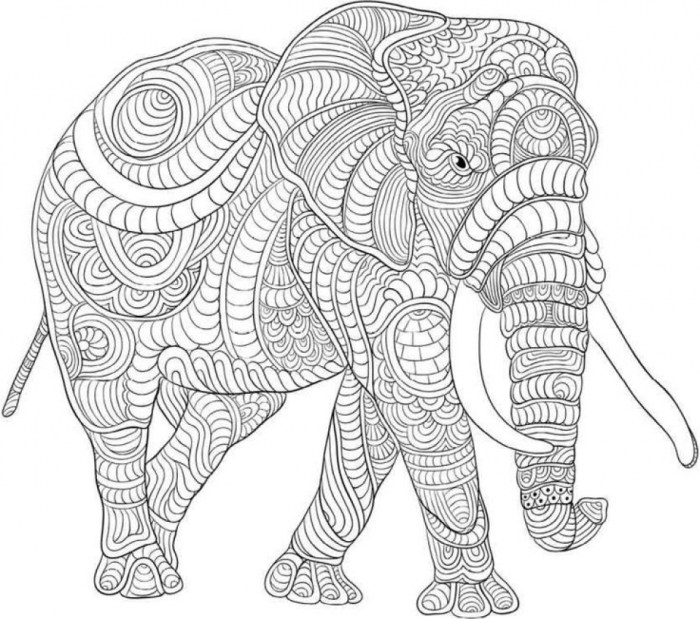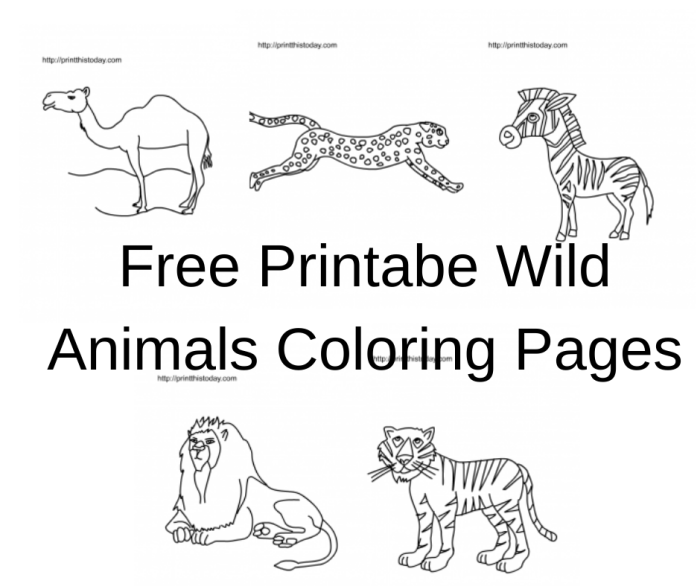Defining “Hard” Coloring Pages for Children

Animal coloring pages hard for kids – Determining the difficulty of a children’s coloring page is subjective, varying significantly based on a child’s age, developmental stage, and fine motor skills. What constitutes a “hard” coloring page for a preschooler will be considerably easier for an elementary school child. The challenge lies in creating engaging designs that appropriately stretch a child’s abilities without leading to frustration.A spectrum of difficulty can be established by considering various visual elements and age ranges.
Preschoolers generally benefit from simple shapes and large areas to color, while older children can handle more intricate details and smaller spaces. The complexity of the shapes, the level of detail, and the presence of small, confined areas all contribute to a coloring page’s difficulty.
Finding animal coloring pages hard for kids can be a challenge, especially when you want something detailed and engaging. For a truly testing yet rewarding experience, try tackling the intricate details of an african buffalo animal coloring page ; its massive horns and textured hide offer a fantastic opportunity for older children to develop their fine motor skills.
The result? A beautifully colored page that proves even the most difficult animal coloring pages can be conquered with patience and precision.
Difficulty Levels and Visual Elements in Animal Coloring Pages
The difficulty of an animal coloring page is primarily determined by the level of detail, the size of the coloring areas, and the complexity of the shapes involved. A simple coloring page might feature a large, single-colored animal shape with minimal details, suitable for younger children. Conversely, a challenging page might include a detailed animal with small, intricate features, many separate areas to color, and complex patterns within the animal’s fur, scales, or feathers.
This necessitates more precise motor control and a longer attention span.
| Image Description | Target Age Group |
|---|---|
| A large, simple Artikel of a cartoon elephant with minimal details. The body, ears, and trunk are all large, single areas to color. | Preschool (Ages 3-5) |
| A detailed illustration of a tiger with stripes composed of many thin, curving lines. The tiger’s face includes small features like whiskers and individual hairs around the eyes. Small areas require precise coloring. | Elementary School (Ages 6-8) |
| A highly detailed rendering of a hummingbird with intricate wing patterns, tiny beak, and numerous small feathers. Requires careful coloring within extremely confined spaces. The page includes a complex background with small flowers and leaves. | Older Elementary/Middle School (Ages 9-12) |
Animal Choices and Complexity: Animal Coloring Pages Hard For Kids

Selecting animals for challenging coloring pages requires careful consideration of their inherent complexity. The intricacy of an animal’s features directly impacts the difficulty level of the coloring page, demanding a higher level of precision and detail from the young artist. Animals with a multitude of fine details, complex patterns, and varied textures present a greater challenge, fostering creativity and fine motor skill development.Animals with intricate patterns and textures, numerous small details, and a high degree of anatomical complexity are ideal choices for creating challenging coloring pages for children.
The contrast between a simple animal like a cat, with its relatively uniform fur, and a more complex animal like a chameleon, with its changing skin patterns and unique scales, highlights the spectrum of difficulty levels achievable. The goal is to create pages that are engaging and stimulating, encouraging children to focus and develop their artistic skills.
Suitable Animals for Complex Coloring Pages
The following animals offer a variety of challenges for young artists due to their unique characteristics:
- Tigers: The intricate stripes require careful attention to detail and precision, demanding consistent line work and color blending to accurately represent the tiger’s coat. The facial features, particularly the eyes and whiskers, also present a challenge.
- Peacocks: The vibrant and elaborate plumage of the peacock offers an opportunity to explore complex patterns and color gradients. The intricate detailing of each feather demands a high level of focus and fine motor skills.
- Chameleons: The bumpy skin texture and the ability to change color provide a unique challenge. Children can explore different color combinations and textures, encouraging creative expression.
- Butterflies: The delicate wings of a butterfly, adorned with intricate patterns and vibrant colors, require precise coloring and attention to detail. The symmetry of the wings also presents a challenge in maintaining consistency.
- Snakes: The scales of a snake offer a repeating pattern that requires consistent coloring and attention to detail. The subtle variations in color and shading can also add to the complexity.
- Parrots: The bright plumage of a parrot, often featuring multiple colors and textures, requires precise coloring and attention to detail. The detailed facial features and beak also add to the challenge.
Comparing Animal Detail Levels
A lion, while majestic, presents a comparatively simpler challenge than a hummingbird. A lion’s mane, while detailed, consists primarily of large, flowing strands. In contrast, a hummingbird boasts a tiny body covered in iridescent feathers with minute details, requiring exceptional precision in coloring to capture the nuances of its plumage and intricate wing structure. The level of detail needed directly correlates with the complexity of the animal’s features.
For instance, a simple animal like a dog might have a relatively uniform coat, while a detailed animal like an insect might have intricate patterns on its wings or body.
Examples of Complex Animal Coloring Pages, Animal coloring pages hard for kids
- Example 1: A Tiger
- Features: Intricate, flowing stripes across the body, requiring careful attention to line work and color blending. Detailed facial features, including eyes, nose, and whiskers, necessitate precision. Muscular structure subtly visible beneath the stripes presents a further challenge for shading and color gradation.
- Example 2: A Peacock
- Features: Elaborate tail feathers with “eyes” that require careful attention to detail and color gradation. The body feathers are also detailed, with varied textures and colors. The precise rendering of the feather patterns requires a high level of precision and focus.
- Example 3: A Morpho Butterfly
- Features: Intricate, iridescent wing patterns with overlapping scales requiring precise coloring and blending. The symmetry of the wings demands careful attention to detail to ensure both sides match. The delicate vein structure of the wings adds another layer of complexity.
Design Techniques for Challenging Coloring Pages

Creating visually engaging and developmentally appropriate coloring pages for children requires careful consideration of design elements. The challenge lies in balancing aesthetic appeal with the need to stimulate fine motor skills and cognitive development. A well-designed “hard” coloring page will present a captivating image while simultaneously providing a rewarding and challenging activity.
Several techniques can be employed to achieve this balance. These techniques leverage visual complexity to create a stimulating experience, while simultaneously demanding precision and control from the child, thereby strengthening fine motor skills.
Shading, Texture, and Pattern Application
The strategic use of shading, texture, and pattern significantly enhances the complexity and visual interest of an animal coloring page. Shading, for example, can be used to create depth and dimension, requiring children to carefully blend colors and modulate pressure to achieve a realistic effect. Think of a lion’s mane—the gradual shift from light to dark tones creates a sense of volume and realism, demanding precise coloring techniques.
Textures, such as fur, scales, or feathers, can be represented through varied line weights and hatching patterns, forcing children to work on a smaller scale and with greater precision. Similarly, intricate patterns on an animal’s skin, like those found on a butterfly or a zebra, present a challenging yet rewarding task for young artists.
Fine Motor Skill Development Through Design
Incorporating fine motor skill development into the design is crucial. This can be achieved through the inclusion of small, detailed areas that require precise coloring and careful control of the coloring tool. Narrow pathways, tiny spots, or intricate patterns within the animal’s design force children to use a light touch and precise movements, thereby strengthening their hand-eye coordination and dexterity.
The smaller the details, the greater the challenge and the more significant the benefit to fine motor skill development. For example, a detailed rendering of a hummingbird’s feathers, each requiring individual coloring, provides a significant fine motor skill workout.
Step-by-Step Guide to Creating a Challenging Animal Coloring Page
Creating a challenging yet engaging coloring page involves a structured process. The following steps Artikel a practical approach:
- Animal Selection and Research: Choose an animal with intricate details and a visually interesting design. For example, a peacock with its elaborate tail feathers, or a snow leopard with its unique spotted coat. Thorough research will ensure accurate representation.
- Sketch Preparation: Create a detailed sketch of the chosen animal. Pay close attention to anatomical accuracy and include fine details such as fur texture, scales, or patterns. Consider using light pencil strokes to make erasing easier and allow for adjustments.
- Detailing and Line Weight Variation: Add details to the sketch, varying line weight to suggest texture and depth. Thicker lines can represent the Artikel, while thinner lines can create finer details such as individual hairs or scales. This variation enhances the visual complexity and provides opportunities for fine motor skill development.
- Shading and Texturing: Incorporate shading to create depth and volume. Use hatching, cross-hatching, or stippling to suggest texture in fur, feathers, or scales. This adds complexity and encourages children to experiment with color blending and pressure control.
- Pattern Integration: Incorporate intricate patterns where appropriate. These could be natural patterns like spots, stripes, or more complex designs found on certain animal species. This provides a significant challenge for the child’s fine motor skills and concentration.
- Final Refinement: Review the sketch for any areas needing improvement. Ensure that the level of detail is appropriate for the intended age group while still providing a sufficient challenge. Clean up any stray lines or unnecessary marks before finalizing the design.

